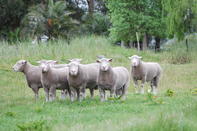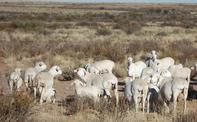In South Africa, sheep are commercially farmed for either meat or wool, but certain breeds yield good quality and quantity of both. This article will focus on sheep breeds used in South Africa for meat production only. Apart from the most commonly farmed breeds listed below, there are also developing breeds in SA, such as the Boesmanlander and the Bezuidenhout.

Dorper Sheep
The Dorper sheep was developed in South Africa and bred through the crossbreeding of the Persian sheep, Dorset and Van Rooy sheep. This resulted in a hardy, fast-growing meat breed suitable for low-rainfall regions.
The Dorper is a large and strongly-built meat sheep with a white body and black head. This fast-growing fertile breed produces lambs that are slaughter-ready at four months. The breed does not require shearing and its skin - with a smooth grain and no creasing - can be used for leather.
Black-headed Persian Sheep
The Black-headed Persian sheep is an ancient meat breed, and is believed to have originated in Somalia or the Middle East. The Persian (or ‘Persie’ in Afrikaans) is a fat-tailed sheep, covered in hair and is, therefore, well-adapted to hot, arid climates. The hornless sheep have long drooping ears, similar to goats. The three colour varieties of the Persian are the blackhead (90%), redhead (4%) and the speckled Persian (6%). Persians are excellent mothers with an even temperament. The breeding interval is 8 months and a high percentage of twins are produced.
It is bred exclusively for its meat, although its skin - the blackhead Persian specifically - can be used for the production of thin, high-grade leather products. The Persian is more resistant to disease than other sheep breeds and has been used for breeding with other breeds to improve their meat production.
Ile de France Sheep
The Ile de France sheep is a French meat breed, introduced in South Africa in 1903 for research. Commercial farming with this breed only started in the 1970s. The Ile de France is a large, smooth-bodied polled meat breed, producing strong white wool of 23 - 27 micron. Wool can contribute up to 20% of this breed’s income. However, most consider the Ile de France a meat breed only, due to the rams’ use in crossbreeding, to produce heavy early-maturing slaughter-ready lambs. First lambing is at 23 months, with little birthing problems. The Ile de France can be used for their milk and is classified as a dairy sheep in the USA.
Van Rooy Sheep

A South African ‘developed’ meat sheep, the fertile Van Rooy sheep was bred to thrive in the drier climates of Southern Africa, typical of fat-tail breeds. The Van Rooy is a medium to large hornless sheep covered with white hair, with a thin wool undercoat on the front part of the body. It has a prominent chest with a dewlap and a fat tail. Fat distribution is localised in the rump and tail. Its thick skin makes the Van Rooy less susceptible to external parasites.
The fertile Van Rooy produce and raise lambs in extremely harsh conditions. It is often used in crossbreeding, due to its unique gene pool. Age of first lambing is 16 months. The Van Rooy exhibits a fast growth rate, and rams are often used to crossbreed with other sheep breeds, to produce lambs with good growth rate and early fat accumulation.
Meatmaster Sheep
The Meatmaster sheep is another South African-developed meat breed, bred from the Damara, Dorper, Van Rooy and Ile de France breeds. The aim was to develop a hardy, fertile, meat sheep with low input costs, suitable for veld grazing systems. The Meatmaster was registered as a breed in 2007 and the Meatmaster Breed Society was established in 2008.
The Meatmaster is a non-fat tail medium-sized sheep, covered in a coat of short shiny hair of various colours and has a short woolly undercoat. The Meatmaster 100-day weaning weight is 27 kg. Meatmaster lambs can be slaughtered at five months of age, at around 38 kg, and may yield a carcass of 17.5 kg.
By Marinda Louw